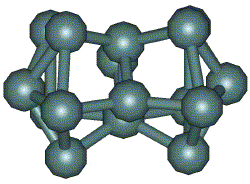Hearty Tin Clusters

A cluster of a few million metal atoms is easier to melt than a much larger chunk. Atomic clusters have many of their atoms on the surface, where they make fewer bonds with their neighbors than interior atoms do, so less heat is needed to break the bonds and melt the crystal. As researchers have measured smaller and smaller clusters, they’ve found lower melting points–until now. According to the 18 September PRL, tin clusters with between 15 and 30 atoms apiece have melting points at least 50 K higher than bulk tin. Although the authors cannot yet explain the effect, it suggests that nanoscale devices may be able to operate at higher temperatures than previously thought.
The most popular method for measuring the melting point depression is to put a cluster in an electron microscope and heat it until the electron diffraction pattern disappears, indicating that the crystalline structure has broken down. But that technique works only for clusters with about a thousand or more atoms; measuring the melting temperature of much smaller clusters is more difficult. “You can’t stick these things on a thermometer,” notes Martin Jarrold of Northwestern University in Evanston, Illinois.
Jarrold and graduate student Alexandre Shvartsburg developed a technique to measure the melting point of clusters as small as 15 atoms, and they were surprised by the results. In their experiments, the team blasted a tin rod with a laser pulse to evaporate individual ionized atoms, which then cooled to form clusters of 15 to 30 atoms. They then sent the clusters through a mass spectrometer, which gave the exact number of atoms in each one. Following the spectrometer, the clusters were sent into a temperature-controlled drift chamber filled with helium, in which the researchers measured the time a cluster took to move the length of the chamber under the influence of an electric field. This so-called mobility measurement is sensitive to the shape of the cluster because a cigar-shaped cluster collides with more helium atoms than a sphere of the same mass. At the melting point, the normally cigar-shaped tin clusters would become spherical, and their mobility would increase.
But the team never saw the transition. “We kept on raising the temperature and kept on seeing no effect,” recalls Jarrold, until they reached their heater’s maximum temperature of 555 K, 50 K above tin’s bulk melting point. Jarrold admits that he can’t explain the anomaly, but he speculates that it’s related to the unusual cigar shapes adopted by tin clusters with fewer than 30 atoms–a configuration the team discovered in previous work [Phys. Rev. A 60, 1235 (1999)]. Small silicon and germanium clusters also adopt these shapes, but their bulk melting points are too high for the team to look for the same behavior with their current set-up. Recent computer simulations [Phys. Rev. B 61, 2329 (2000)] appear to confirm the results, suggesting that very small tin clusters should melt above 900 K and that silicon and germanium should also have melting points higher than their bulk values. Jarrold points out that since silicon is a popular material for nanotechnology, it’s possible that nanodevices may survive up to higher temperatures than expected.
“It’s a very exciting experiment that will certainly cause a lot of interest among theoreticians,” says David Wales of Cambridge University, because current theories cannot account for the results. But Wales is confident the theorists will prevail, and however they explain the effect, “we will learn something which will certainly be interesting.”


